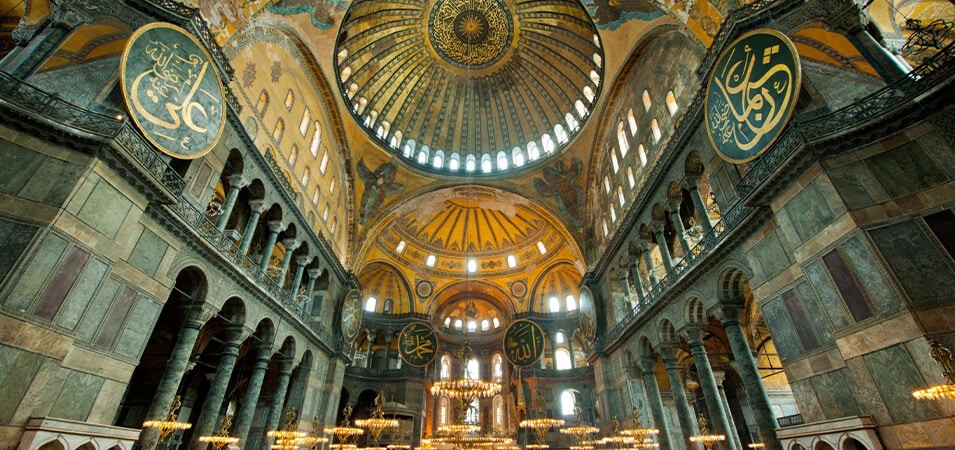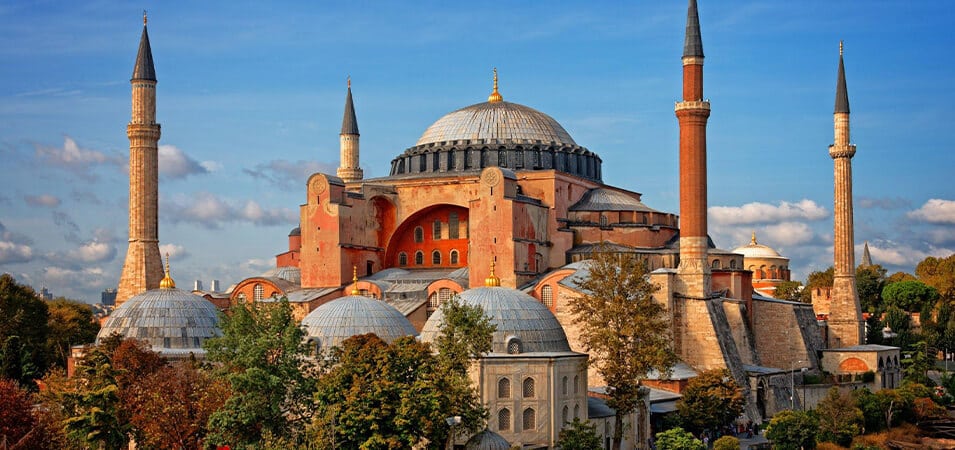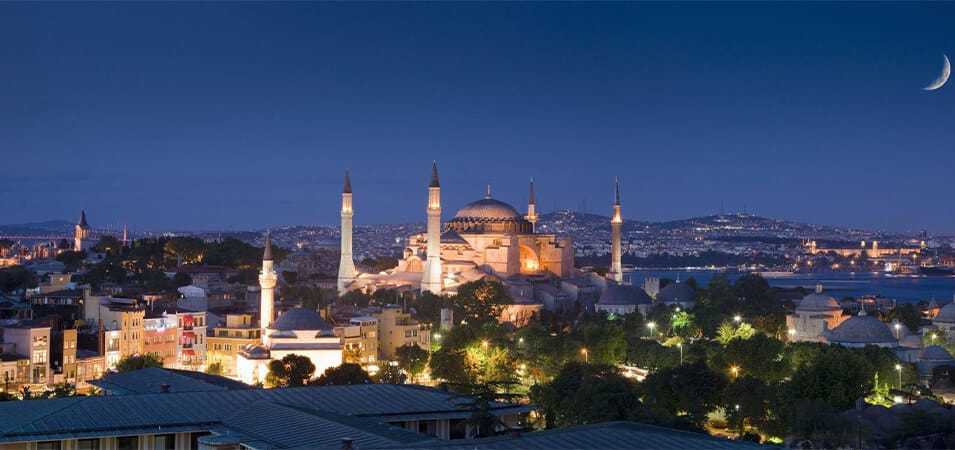The Hagia Sophia Cathedral, with its timeless beauty and historical significance, stands as a testament to the rich cultural heritage of Istanbul, Turkey. In the sixth century, it was built as a Christian church. It later became a mosque, and now it is a museum that draws people worldwide with its beautiful building and deep meaning.
The Hagia Sophia Cathedral, also called Ayasofya, is a gem of Byzantine architecture. It is right in the middle of Istanbul’s ancient peninsula. Anthemius of Tralles and Isidore of Miletus were the builders who built the church. It has a great dome that rises high into the sky, representing the stars and making people feel awe.
As we learn more about the Hagia Sophia Cathedral’s timeless beauty, we ask you to look at its beautiful architecture, learn about its history, and consider the more extensive talks about its cultural and religious importance. Join us on this trip through time and be amazed by how one of the world’s most famous sites has stood the test of time.
Don’t Miss checking out our Turkey Tour Packages.
Historical Background of Hagia Sophia Cathedral

The Origins of the Hagia Sophia Cathedral:
The Hagia Sophia Cathedral was built during the 6th century, when Emperor Justinian I was in charge of the Byzantine Empire. As part of Justinian’s bold building plan, the church was created to return the Roman Empire to its former glory.
Construction during the Byzantine Empire:
The Hagia Sophia’s building began in 532 CE and was finished in five years. Anthemius of Tralles and Isidore of Miletus were given the job of making plans for this huge building. They worked together to create a church that combined new engineering methods with beautiful architecture.
One of the most well-known things about the Hagia Sophia is its vast dome, which is 32 meters in diameter and 55.6 meters high. The crown was held up by pendentives, which are triangular pieces that helped the shift from the dome’s round base to the square walls. This new way of building made it possible for the inside to be big and full of natural light.
People saw beautiful tiles and marble decorations when they entered the Hagia Sophia. These beautiful sculptures included pictures of Jesus Christ, the Virgin Mary, and other saints. The artworks were inspirational and educational for the Christians of Byzantium, showing them how important Christianity was to their lives.
Hagia Sophia Cathedral: Architectural Marvels

The impact of Byzantine architecture:
The Hagia Sophia Cathedral is a beautiful example of a Byzantine building. Its size, detailed design, and innovative engineering make it a great example. There are hints of Byzantine architecture all over the building, which shows the culture and artistic heritage of the Byzantine Empire.
The Byzantine style of architecture was based on the types of Roman and Greek buildings. It used things like domes, high ceilings, and elaborate decorations. With its famous crown, intricate tiles, and use of marble and other expensive materials, the Hagia Sophia shows how these styles came together.
The dome of Hagia Sophia is a marvel of engineering:
The Hagia Sophia’s dome is a feat of engineering that has amazed people for hundreds of years. The dome was made by Anthemius of Tralles and Isidore of Miletus. It has a diameter of 32 meters and stands 55.6 meters tall. It is an excellent example of an early building that used new ideas.
The builders used a system of pendentives and semi-domes to hold up the massive weight of the dome. Pendentives are the triangular pieces that connect the dome’s round base to the building’s square walls. This engineering feat made building a large room under the dome possible.
The dome’s base has windows called lunettes that let in natural light and give the impression that the crown is not there. Even now, architects and engineers are still inspired by the dome’s building methods, which were very new at the time.
Hagia Sophia Cathedral Conversion into a Mosque
Sultan Mehmed II and the change:
After Mehmed II, known as Mehmed the Conqueror, took over Constantinople in 1453, he turned the Hagia Sophia into a mosque. This change occurred because the Ottoman Empire took over after the Byzantine Empire lost power.
Additions and changes to architecture by Muslims:
As a mosque, the Hagia Sophia had to be rebuilt in a way that was more in line with Islamic customs. With minarets and mihrabs, Islamic features were added to the building. In Islamic prayer, these changes were beneficial and meant something.
Preservation and Restoration:
Transition into a Museum: Historical Turning Point:
As part of Mustafa Kemal Atatürk’s plan to make Turkey a democratic state, the Hagia Sophia was turned into a museum in 1935. This change was a turning point in the history of the Hagia Sophia. It went from being a place of worship to where history and culture are kept.
Efforts to fix things and problems:
The Hagia Sophia has undergone many repair projects to keep its architectural and artistic history alive. Restoration projects have aimed to fix structural problems, secure the building, and protect the mosaics and paintings that are still there. But these repair attempts have also run into problems because the structure is complicated and needs to be kept in good shape.

Cultural Significance of Hagia Sophia Cathedral
Hagia Sophia as a symbol of religious coexistence:
As a reminder of how different religions can live together, the Hagia Sophia is an essential part of the culture. In its long past, the building has been a church and a mosque, showing how Byzantine Christianity and Islamic customs could live together. This mixed religion history shows how different beliefs in the area have changed over time and how they affect each other.
Influence on Byzantine and Ottoman art and architecture:
The building and art of the Hagia Sophia had a significant impact on both Byzantine and Ottoman art and design. Its distinctive dome design, use of tiles, and Islamic features have long served as inspiration for artists and builders.
Byzantine art and architecture were influenced by how great the Hagia Sophia was. This created a unique Byzantine style with towers, elaborate tiles, and many fancy details. In the same way, turning the Hagia Sophia into a mosque affected the Ottoman building. Mosques built after the Hagia Sophia incorporated design elements and features from the Hagia Sophia.
conclusion
The Hagia Sophia Cathedral is an excellent example of how creative people can be and how well different cultures and religions can live together. From its time as a Byzantine wonder to its time as an Ottoman mosque and then a museum, the Hagia Sophia has seen many political, architectural, and cultural changes over a thousand years.
With its awe-inspiring dome and innovative building methods, this architectural masterpiece shows how brilliant Byzantine engineers were. The art of the Byzantine Empire can be seen in the elaborate tiles and paintings used to decorate the inside.
The fact that the Hagia Sophia was turned into a mosque shows how power and religious views in the area have changed over time. By adding minarets and mihrabs, which show that Islam has won, Islamic building features were quickly added.
Don’t Miss checking out our Related Article :
